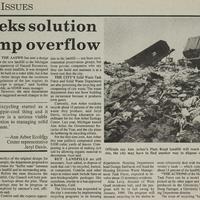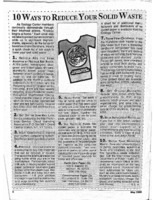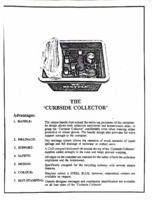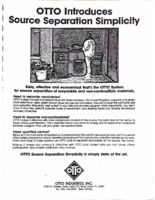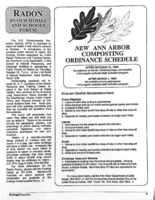See a related article from the Ecology Center's website, From Leaky Landfill to Material Recovery: The 1990 Ann Arbor Environmental Bond
Solid Waste Management
Landfill Shortages: A Statewide Problem
Ten years before the Ecology Center published their proposal for mandatory recycling in Ann Arbor, the state of Michigan knew it was running out of landfill space. In 1978, Michigan's nine-million residents produced an estimated 26,000 tons of general waste and 130 tons of hazardous waste per day. However, 64 out of the state's 83 counties didn’t have approved landfills, or anticipated running out of landfill space by the end of the decade. To further complicate matters, there were no hazardous waste facilities in the Michigan. Faced with an impending disaster, the Department of Natural Resources (DNR) welcomed the Michigan legislature's passage of Public Act 641 of 1978 (Solid Waste Management Act) and, the following year, Public Act 64 (Hazardous Waste Management Act). These bills introduced new - and strict - environmental protection standards at licensed landfills in the hopes of reducing groundwater contamination, as well as overall waste production.
Despite the passage of these laws, creating landfill space in Ann Arbor was a race against the clock. Although Washtenaw County submitted a 20-year solid waste management plan in 1982, per the requirements of Public Act 641, the Ann Arbor Sanitary Landfill (Type II) was slated to run out of space by 1988. The city had requested an expansion, but any extra capacity would be subject to numerous restrictions from the DNR. In the meantime, alternatives to landfilling would need to be found, and quickly.
The Solid Waste Task Force and Resource Recovery Strategy
In 1986, the city of Ann Arbor created a Solid Waste Task Force (SWTF) to investigate alternatives to a landfill. Debates in the SWTF focused on two primary methods: recycling and incineration. Described as a silver-bullet solution, incineration burned materials that would otherwise be landfilled. Enthusiasm was particularly high about "waste-to-energy incineration." This method burned waste to generate electricity and steam that was then sold to energy and utility companies. Environmentalists, however, were quick to point out that incineration caused new problems for air pollution, including the release of harmful chemicals like dioxin generated from burning plastics.
Cognizant of incineration's effect on air pollution and destruction of material that could otherwise be reused, the Ecology Center emphasized their own resource recovery strategy focused on finding new outlets for recycling. In the December 1983 Ecology Report, Wendy Wilson explained,
"Reducing wastes, reusing and recycling are suggested as the most efficient methods for recovering our natural resources. But source reduction and source separation programs must be specifically tailored to the needs of each locality. Changing peoples’ household habits, maintaining a consistent public education program and developing strong local government support are critical prerequisites to successful recycling or waste reduction efforts.”
Recycling increasingly came to be seen as a more positive alternative, especially when a feasibility study for Waste-to-Energy Incineration revealed it would raise waste disposal costs by 300%.
The Ecology Center Mobilizes
In 1987, only a year away from running out of landfill space in Ann Arbor, the Ecology Center developed a comprehensive policy statement. Their three major recommendations were:
-
Implementing an integrated waste management system that prioritized reducing, reusing, and recycling first, and landfilling and incineration only as a last resort.
-
Expanding the current recycling industry and creating and distributing products made from recyclable materials.
-
Maintaining incineration only if it satisfied certain environmental criteria like using effective emissions control technology, following source separation prior to incineration, properly disposing of hazardous waste.
In 1987, the city's Solid Waste Task Force published its report with recommendations for a “multi-faceted approach to waste management.” Largely favoring the report's findings, the Ecology Center encouraged members to attend town hall meetings where the SWTF's recommendations would be discussed publicly. At meetings, the EC advised attendees to endorse recycling and composting and share any new actions they would take under a more ambitious recycling program. The EC hoped the combination of participation and constructive suggestions would encourage the city council to more directly support the EC's vision for solid waste management in Ann Arbor.
The following year, the EC formed the Solid Waste Environmental Action Team, or S.W.E.A.T. Led by EC members including Brian Wanty and Rebecca Kanner, S.W.E.A.T. concentrated their efforts on businesses and organizations and encouraged them to use recycled paper and other products.
The EC Takes Action: Mandatory Recycling Ordinance of 1988
Observing positive trends toward integrated waste management (a combination of strategies that included composting, recycling, landfill, and waste reduction), in November 1988 the Ecology Center and Recycle Ann Arbor issued a joint statement addressed to Mayor Jernigan, city council, and city administrators advocating mandatory recycling in Ann Arbor. This proposal framed recycling as a crucial and cost-effective strategy to mitigate the city’s growing solid waste management crisis. The EC's statement contained three proposals:
-
Mandate the separation and collection of recyclable waste in single and multi-family houses, and increase to a weekly rather than monthly collection.
-
Ban the disposal of recyclable and compostable material at the Ann Arbor landfill.
-
Implement a fee structure for trash collection depending on the volume of garbage generated by households.
The Ecology Center received support for this ordinance from the newly-formed Ann Arbor Recycling Coalition - a collaboration that included the League of Women Voters, Association for the Advancement of University Women, Huron Valley Sierra Club, Project Grow, Huron Valley Greens, and the Augusta Environmental Strategy Committee. The EC also had support from city residents; according to a survey from the Solid Waste Task Force, 65% of Ann Arborites supported mandatory recycling.
The proposed ordinance was met with a largely positive reaction from City Council, though it took about two years to resolve fully due to legal technicalities. A small victory occurred in July 1989, when compostable yard waste was banned from the landfill. After several months of conversation and debate, the city council approved a mandatory recycling ordinance in November, 1990 that included all of the Ecology Center’s proposals.

